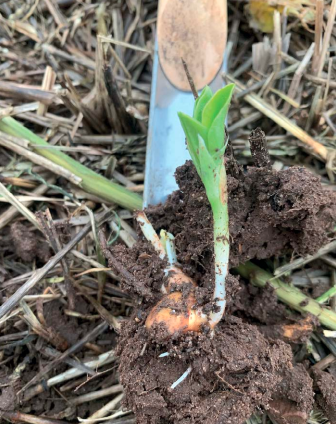
If I was ever to write the script for a farming based horror movie I think the title may simply be “2020’’ ! Last time I wrote it was December 2019 and we were only 60% through our autumn drilling campaign. Well behind our usual planned October finish. The new 12m Horsch Avatar had been parked up and our farm workshop Co6 and front hopper tine drill was working in any available dry spell to complete the remaining workload. The Avatar coulter had been impressive in the unusually wet conditions, not blocking in conditions where I’m sure our 750a would have but ultimately its limiting factor was the weight of the seed cart on wet soils.
With a full 12/36m CTF system in place here any soil damage caused by weight on wet, fragile, soils is at least confined to a known and small % of the land which, if necessary, can be targeted to repair. However, repair means soil disturbance I would rather not do so the lightweight and balanced CO, able to run a low tyre pressures seemed the better choice in the extreme conditions. Also of note was the correlation between how long a field had been farmed under conservation agriculture principles and ability to drill, the longer term soils not only able to carry the weight of establishment machinery far better but far less prone to smear against the disc of the avatar or the tine of the C0.
Despite lacking the versatility of a disc when it comes to dealing with huge amounts of green cover and surface trash, on our soils a tine is better when soil is wet, and the less consolidated surface seems to give better establishment later in the season. Over the years of evolution of our tine drill we have experimented with various tine solutions. When first converted we used the Metcalfe points, I was attracted by their narrow profile of just 12mm and low price tag compared to others but quickly found on our stoney soils that the tungsten wear tile would often break off long before the point was worn out and that narrow profile led to very rapid seed tube wear and issues flowing larger seeds like peas and beans.

I set about creating my own modified version, initially this was just a wider version (15mm) using a Ferobibe wear tile that could be replaced with a farm workshop Mig welder. Unlike the tungsten, soil flow still created wear issues with the seed tubes so later protective side plates were added but I was never 100% happy with the design.
In 2019 I had the opportunity to try some Bourgault VOS openers, initially we fitted the twin row 100mm points, the quality was impressive and they worked well but 100mm was too much soil disturbance for my liking so we moved to the 19mm single shot point which seem absolutely perfect, low disturbance yet wide enough to flow even the largest of bean seed and with no seed tube to wear with it being internal to the point. I think this will be the solution we stick with going forward, they were pushed to the limits this year in conditions I hope to never see again, in combination with the Horsch Partner front hopper I think they were the only reason that on February the 15th we finally managed to complete 100% of the “autumn” wheat and bean establishment workload.
Having the right tools for the job and the right soil is only part of the picture, without the commitment, skills and tenacity of good staff no farming system can ever be successful, The herculean effort made by everyone here this season was exceptional, they worked at every available opportunity, safely and efficiently with their usual attention to detail. The sense of achievement by all, against the odds and conditions felt like sweet victory making the second part of this horror story even harder to swallow …

Despite the difficulties of autumn at least our OSR area all looked good, locally a lot of crops had been destroyed by CSFB not long after drilling, yet ours had all made it through winter and although not exceptional looked ‘alright’. As soil temperatures warmed and first nitrogen was applied though it became clear all was not good. Closer inspection revealed stems badly infested with CFSB larvae, there was no way the crop was going to yield, although hard to accept it was a write off and clearly best replaced with a spring crop of linseed creating a significant increase to our spring workload but at least with our low input, low risk approach to OSR the financial impact of losing the crop was minimised with just farm saved seed, a herbicide and 1/3rd of the nitrogen applied we can simply call it a cover crop and move on !
The future of OSR on this farm is doubtful, we seem to have got away without CSFB issues longer than some but it was inevitable it would hit us eventually, pests do not respect farm boundaries or hedgerows so regardless of IPM or soil health on individual farms there is nothing an individual farmer can do to remain immune to this problem.

Unlike many I believe the ban on neonicotinoids is not entirely responsible for this issue. In fact, I think this is a clear example of how unsustainable modern agriculture has become when an entire crop can seemingly no longer be grown. The blame in my opinion for this loss sits firmly at the feet of poor rotation, agronomy and often blatant, historic, disregard of IPM. Afterall I am certain the Romans who bought this crop to the UK farmed without seed dressings and pyrethroid. Yet in just one generation we seem to have made something possible for thousands of years, impossible. If that doesn’t make you question the overall direction of modern farming and its impact upon our environment, then it should, what crop will we be crossing off the options list next I wonder if we don’t change? Blackgrass problems anyone?
In mid-March the rain that had started on September 20th finally stopped rather ominously on Friday 13th of March. A total of 580mm had fallen through that time and only 8 days had no rainfall at all making it even more remarkable that we had somehow got that autumn workload complete. Soils started to dry, and we were soon able to get the spring crop establishment completed in good time and condition. Grateful to finally get some dryer condition to work in establishment was quick and simple compared to the trials and tribulations of the winter. We joked about a drought …….. and then it happened!
It was 82 days later, on June 3, when we had our next rainfall. At this point the wheat was almost dead. Tillers had been dropped and yield potential irreparably capped, spring crops had emerged and developed slowly, I think in some cases had we cultivated to establish them they maybe never have emerged at all. The farm really did not look great, the only consolation being a country in covid 19 lockdown at least I didn’t have to look at it very often!
I’m the first to criticise farmers for moaning, let’s face it, if you can’t deal with unfavourable weather then farming probably is not the best occupation to choose. I prefer to focus on things we can control as managers rather than things we can’t. I chose to accept this season as a challenge, if you can win a game of poker with a bad hand then surely you can still make a margin growing crops with bad weather?

The simplicity of the low fixed cost structure business I have set out to build suddenly felt more prudent that ever with a small payroll and machinery fleet to finance the next focus was on adjusting the variable costs to fit potential.
Fortunately we had applied 60% of the planned N to our wheat early, as the hot, dry conditions persisted it was fear of scorch and damage that led the decision to apply no more but ultimately as tillers aborted it was yield potential finally made the 60% into 100% of planned application. It was a similar story for other inputs, a cheap fungicide application made at T1 timing became all that was needed to keep wheat clean until the rain finally returned in mid-June. Spring crops needed just fertiliser and herbicides; I don’t think we have ever had a year where our usually very busy sprayer has been parked in the yard quite so much.
The result has been an extremely cheap year, ultimately a very simple year. Although we are unavoidably heading into a lower output harvest than we have seen here for many years I think this could be one of the best farm management years I have had, there is not a single decision I think I would change this year, not a single opportunity missed and I don’t think I have ever been able to say that before. I’m looking forward to harvest and remain hopeful that this farming horror story could just have a happy, ie. profitable, ending!